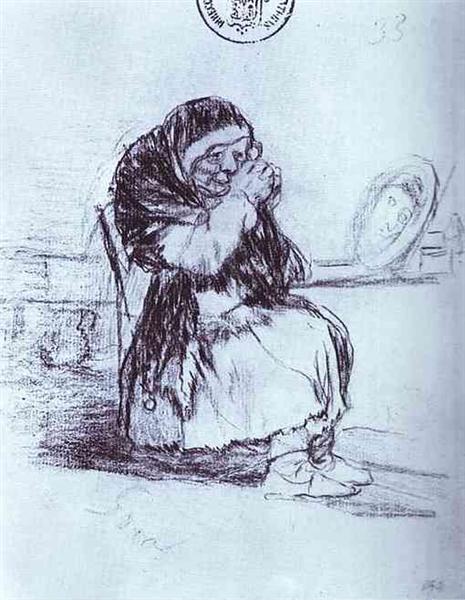תיאור
הציור "הזקנה עם מראה" מאת פרנסיסקו גויה, שנוצר בשנת 1828, מציע מבט חודר למצב האנושי ועל ארעיות הזמן, נושאים חוזרים ונשנים ביצירת המורה הארגוני. שמן זה על בד מציג אישה זקנה המחזיקה מראה בידה, תוך התבוננות בהשתקפותה שלה בביטוי שניתן לפרש כתערובת של הערצה וזלזול. גויה, הידועה בביקורתו החברתית החדה ובחקירתו בצד האפל של הטבע האנושי, משתמש ביצירה זו כדי להיכנס לנפש הזקנה והבלתי.
מנקודת המבט ההרכב, העבודה בולטת בפשטותה וגישתו הישירה לדמות המרכזית. הזקנה תופסת את המקום הבסיסי של הציור, מוקף ברקע כהה המשפר את דמותה, ומאיר אותו לעומת זאת. שימוש זה בניגוד בין אורות לצללים, האופייני לסגנון האפל שגויה אימץ בכמה מיצירותיו, מעצים את תחושת הבידוד של הנושא ומגביר את הדהוד ההתבוננות שלו. נראה כי היד שמקיימת את המראה מסמלת לא רק מעשה של שליטה עצמית, אלא גם את הענווה הבלתי נמנעת של חלוף הזמן.
הצבע ממלא תפקיד מכריע בביצוע היצירה. גויה משתמשת בפלטת צבעים כהה בעיקר - גוונים חומים ואפורים שולטים ברקע - מבליטים את הפנים המטושטשות של הזקנה. עורו המקומט, מגע ומלא בחיים, מנוגד חזותית למראה, המאירה בהשתקפויות עדינות שתופסים את האור. זה לא רק מכוון את תשומת ליבו של הצופה לאישה הזקנה ולהשתקפותה, אלא גם גורם להרהור על המשמעות של הזדקנות ויופי חלופי שמתורגם לסוג של דיאלוג פנימי.
יש לציין כי עבודה זו היא חלק מתקופה מאוחרת של גויה, בה הסגנון שלו התפתח לגישה אישית יותר וטכניקה רופפת יותר, מה ששיקף לעתים קרובות את מצבו הרגשי והפיזי בהקשר של אכזבה ומחלות הולכות וגוברות. במהלך השנים הללו, גויה צוללה למשבר שנראה כי רחוק מגביל את היצירתיות שלה, העשיר אותה בעומק פסיכולוגי יוצא דופן.
דמותה של הזקנה, שכבר כשלעצמה סמל לפגיעות אנושית, חושפת את דאגותיו של גויה ביחס לתפיסת הזקנה בחברה. המראה, המסמלת באופן מסורתי אמת והערכה עצמית, הופכת לכאן אלמנט אמביוולנטי המתגדיר את רעיונותיו של עצמיות, וחושף אמת גולמית על תמותה. במדיטציה שלו על יופי אבוד, גויה מזמין את הצופה להצטרף להתבוננות זו לפגיעות ובלתי נמנעות של חלוף הזמן.
לסיכום, "הזקנה עם מראה" היא לא רק ייצוג של זקנה, אלא מחקר רגשי עמוק המכיל בפני עצמו את החששות לגבי זהות ומעבר הזמן. השליטה הטכנית של גויה ויכולתו לתפוס את מהות האדם בתמונה סטטית הם, ללא ספק, המורשת שנמשכה והדהדה לאורך המאות. בעבודה זו, חשיבותם של פרטים יומיומיים הופכת למראה של מציאות הקיום הטרנסצנדנטלית.
KUADROS ©, צבע מפורסם על הקיר שלך.
ציורי שמן בעבודת יד, עם איכות אמנים מקצועיים וחותם ייחודי של KUADROS ©.
שירות רבייה בתמונות עם ערבות שביעות רצון. אם אינך מרוצה לחלוטין מהעתק הציור שלך, אנו מחזירים את הכסף שלך 100%.

